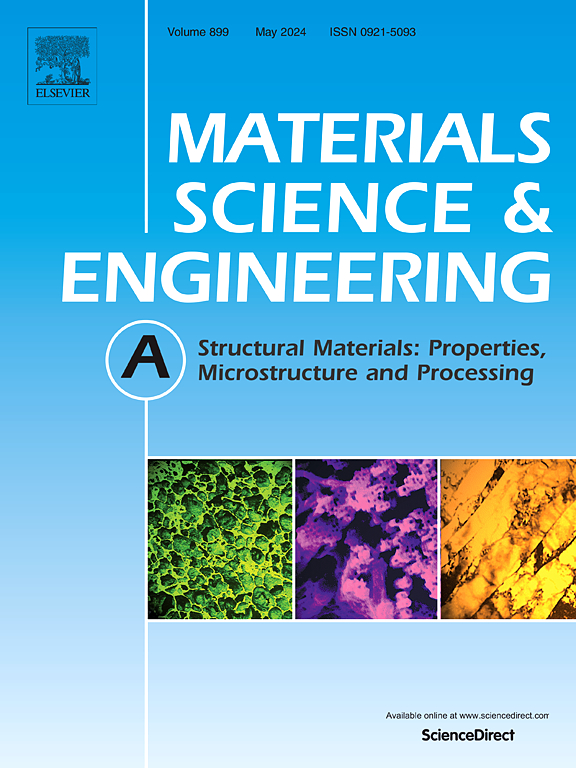Unveiling the abnormal grain growth behavior in diffusion-bonded joints of zirconium alloys enhanced by gradient nanostructures
IF 7
2区 材料科学
Q1 MATERIALS SCIENCE, MULTIDISCIPLINARY
引用次数: 0
Abstract
Gradient nanostructured (GNS) materials have shown benefits in the diffusion bonding process; however, the occurrence of abnormal grain growth (AGG) of GNS materials at high temperatures remains insufficiently explored, particularly in relation to joint microstructure and properties. Herein, gradient nanostructures were fabricated on Zr-4 alloy plates via ultrasonic impact treatment, and subsequently utilized in diffusion bonding at 740–800 °C. The fabricated GNS-Zr exhibited a gradient microstructure, transitioning from surface nanograins (minimum of ∼40 nm) to coarse-grained regions within the matrix. During diffusion bonding, the thermal instability of GNS-Zr triggered AGG, forming a novel layered bimodal structure in the bonded joints, characterized by rapidly grown nanograins (RGGs), abnormal large grains (AGs), and normally grown grains (NGs). The AGs reached up to eight times the size of the original matrix grains at 800 °C, allowing their orientations to dominate the overall texture. The formation of AGs was driven by the non-uniform distribution of stored strain energy in GNS-Zr, with most grain orientations inherited from the original matrix. Although AGs exhibited lower hardness and greater susceptibility to twinning, the layered bimodal structure enhanced the joint shear strength through heterogeneous deformation between AGs and surrounding finer grains. This interaction provided additional work-hardening to the smaller grains while also improving the effective strength of AGs. Consequently, AGG contributed to a significant enhancement in joint shear strength by 39.8 % at 780 °C and 21.8 % at 800 °C compared to joints bonded with as-received Zr-4. These findings highlight the essential role of AGG in determining joint properties and offer insight into the microstructural design strategies for diffusion-bonded joints.
揭示了梯度纳米结构增强锆合金扩散连接接头中异常晶粒生长行为
梯度纳米结构(GNS)材料在扩散键合过程中表现出优势;然而,对于GNS材料在高温下异常晶粒生长(AGG)的发生机理,特别是与节理组织和性能的关系,研究还不够充分。本文通过超声波冲击处理在Zr-4合金板上制备了梯度纳米结构,并在740-800℃进行了扩散键合。制备的GNS-Zr呈现出梯度微观结构,从表面纳米颗粒(最小约40 nm)过渡到基体内的粗颗粒区域。在扩散键合过程中,GNS-Zr的热不稳定性触发了AGG,在键合接头中形成了一种新的层状双峰结构,其特征是快速生长的纳米晶粒(RGGs)、异常大晶粒(AGs)和正常生长的晶粒(ng)。在800℃时,AGs的尺寸达到了原始基体晶粒的8倍,使其取向主导了整体织构。AGs的形成是由GNS-Zr中存储应变能的不均匀分布驱动的,大多数晶粒取向继承于原始基体。虽然ag的硬度较低,且易孪晶,但层状双峰结构通过ag与周围细晶粒之间的非均质变形增强了节理的抗剪强度。这种相互作用为较小晶粒提供了额外的加工硬化,同时也提高了AGs的有效强度。因此,在780°C和800°C时,AGG显著提高了接头的抗剪强度,分别提高了39.8%和21.8%。这些发现强调了AGG在确定接头性能方面的重要作用,并为扩散键合接头的微观结构设计策略提供了见解。
本文章由计算机程序翻译,如有差异,请以英文原文为准。
求助全文
约1分钟内获得全文
求助全文
来源期刊

Materials Science and Engineering: A
工程技术-材料科学:综合
CiteScore
11.50
自引率
15.60%
发文量
1811
审稿时长
31 days
期刊介绍:
Materials Science and Engineering A provides an international medium for the publication of theoretical and experimental studies related to the load-bearing capacity of materials as influenced by their basic properties, processing history, microstructure and operating environment. Appropriate submissions to Materials Science and Engineering A should include scientific and/or engineering factors which affect the microstructure - strength relationships of materials and report the changes to mechanical behavior.
 求助内容:
求助内容: 应助结果提醒方式:
应助结果提醒方式:


